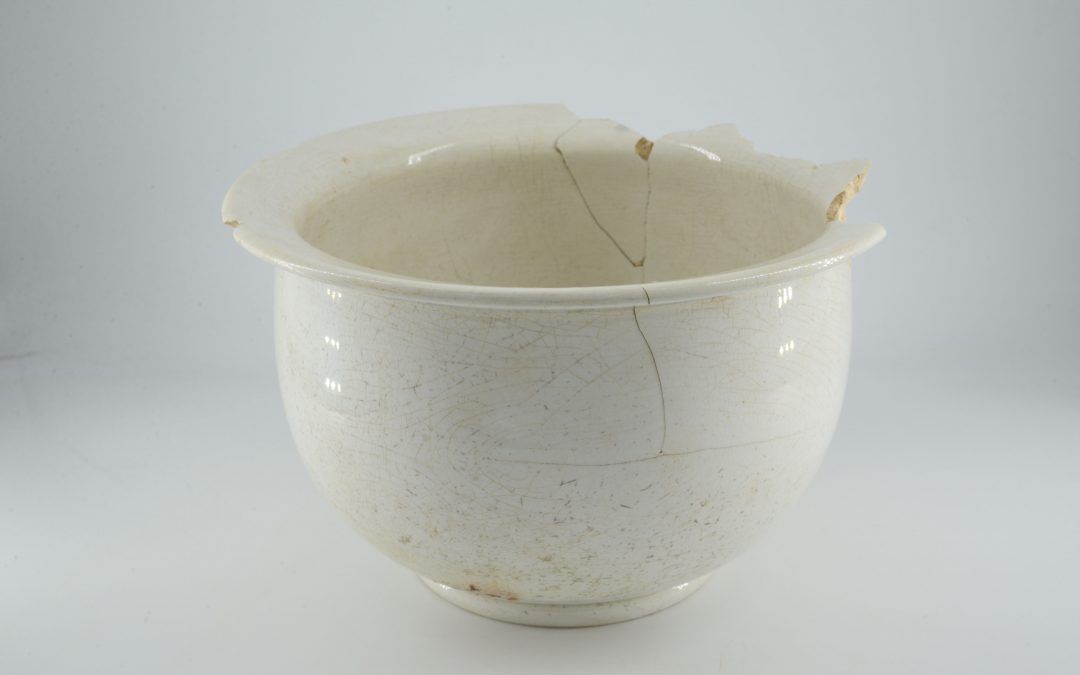
‘Babes in the Wood’ was the name originally given to a timber hut that was built by convicts in 1790.
It was first known as the ‘Hawkesbury Settler’ inn located on the south east corner of George and Smith Street. The first licensee of the inn was Andrew Nash who ran the inn from 1813. Following him was Bill Watkins who became the new publican from 1825. In 1829 a fire ravaged the building which was rebuilt by a wealthy Parramatta citizen, Nathaniel Payten who became the next publican. He renamed the inn ‘The Babes in the Wood’. [2]
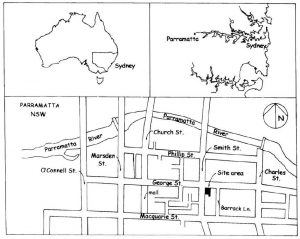 Site location. Source: Martin Carney. [3]
Site location. Source: Martin Carney. [3]
Nathaniel Payten was a prominent figure who built many of Parramatta’s famous landmarks such as Parramatta Gaol, All Saints Church, Perth House and Houison Cottage. [4] After the death of Payten, James Bridges became the licensee from 1837 to 1847 and it was then taken over by James Carvey who ran the inn from 1848 until 1870. [5] Later, much of the hotel site was sub-divided into a series of allotments. The first was sold to Isaac Waugh in 1881. The subdivision resulted in the partial demolition of the inn. [6] It was replaced by a number of out buildings including a two-storey house. The cottage and the stables remained and the stables underwent considerable alterations between 1877 and 1895. [7]
 Aerial view of the Babes in the Wood excavation site. Source: Edward Higginbotham. [8]
Aerial view of the Babes in the Wood excavation site. Source: Edward Higginbotham. [8]
Over the years many buildings have been constructed on the site, such as a hospital named ‘Inchneuk’ which was built by Dr Bowman in 1887. It remained operational until the 1950s. [9] From 1950 to 1970 the building was named the Lennox Hotel and a few blocks away stood the Roxy Theatre. On the site bounded by George and Macquarie Streets, was the location of Emanuel Brown’s cordial factory. This is perhaps why there are so many bottles found at the ‘Babes in the Wood‘ excavation site.
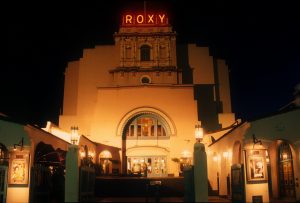 The facade of the Roxy Theatre at night, Parramatta c. 1980. Source: Parramatta Heritage Centre. [10]
The facade of the Roxy Theatre at night, Parramatta c. 1980. Source: Parramatta Heritage Centre. [10]
‘Babes in the Wood’ was excavated initially in 1985 and then other parts of the site were excavated in 1989, in what was known as the Prospect Electricity Carpark, by Edward Higginbotham. In his report a large assortment of artefacts were uncovered, over the four phases of the excavation site. There were many artefacts which gives clues as to the living conditions in the penal colony in Parramatta. The excavation site consisted of some huts in which convicts lived. An historical document talks about the repair of the huts soon after they were built. It reads:
“…originally built by Governor Phillip for the reception of convicts, but which had been some years neglected, and were now in a state of ruin. Many indeed had fallen down”. [11]
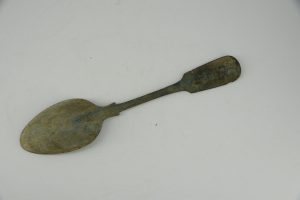 A silver-plated spoon discovered at the Babes in the Wood excavation site, c. 1800s-1850. Source: Parramatta Heritage Centre, BIW_1989.00864. [12]
A silver-plated spoon discovered at the Babes in the Wood excavation site, c. 1800s-1850. Source: Parramatta Heritage Centre, BIW_1989.00864. [12]
Higginbotham catalogues the artefacts under the basis of principal purposes and functional analysis. The dating of artefacts is an important consideration because the dating of the site can be determined in relation to the stratigraphic evidence. They are divided in terms of; Aboriginal artefacts, bone materials, building materials, ceramics, glass, kaolin (soft white clay), metals, miscellaneous coins, miscellaneous-other, organics, shell unworked, stone and synthetics. [13] By looking at the wide variety of key functions of the site, ‘Babes in the Wood’ had access to a wide range of goods and services between the 1820s and 1880s.
 A blue ceramic earthenware teacup discovered at the Babes in the Wood excavation site, c. 1800s-1850. Source: Parramatta Heritage Centre, BIW_1989.00943. [14]
A blue ceramic earthenware teacup discovered at the Babes in the Wood excavation site, c. 1800s-1850. Source: Parramatta Heritage Centre, BIW_1989.00943. [14]
As a result of looking at the artefacts, Higginbotham concluded that the ‘Babes in the Wood’ Hotel occupied the site from the 1810s to the 1880s. [15] The artifactual evidence is ambiguous but relays the key functions of the site which was also categorised into its own subject matter. This includes “aerated water, alcohol, barrels, containers, kitchenware, medicine, smoking, tableware, and toilet” and most importantly the presence of this artifactual evidence demonstrates hotel use. [16]
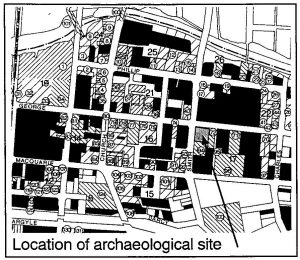 Location plan of the archaeological site. Source: Edward Higginbotham [17].
Location plan of the archaeological site. Source: Edward Higginbotham [17].
The consistent presence of tableware, ceramics and porcelain indicates that the hotel was used for more than just the sale and consumption of liquor, but provides evidence for catering and accommodation. The hotel was the centre of a fully-fledged market economy and it remained that way until the arrival of the railway in 1855. [18] Its extension in the 1850s and 1860s lead to the decline of the town as a stopover in travellers’ journeys westward. This begs the question as to whether or not New South Wales as a whole was still experiencing difficulties in meeting the needs of the population for marketed or imported goods? It appears, based off the artifactual evidence found that ‘Babes in the Wood’ did not struggle financially until the railroad was erected in 1855.
 A Bristol glazed ginger-beer bottle at the Babes in the Wood excavation site, c. 1800s. Source: Parramatta Heritage Centre, Accession number, BIW_1989.00942 [19].
A Bristol glazed ginger-beer bottle at the Babes in the Wood excavation site, c. 1800s. Source: Parramatta Heritage Centre, Accession number, BIW_1989.00942 [19].
It is evident that the archaeology of the site resulted in a large number of important archaeological finds. This includes the discovery of another convict hut dated to the 1790s. [20] Apart from this the artefact assemblage found at the excavation site provides a detailed insight into the living conditions of convicts and the early development of the town. The artefact collection which is mostly held by the Parramatta Heritage Centre provides an invaluable document into the past of Parramatta.
![]() Adam Wilson, Volunteer Archaeology Researcher, City of Parramatta, Parramatta Heritage Centre, 2018.
Adam Wilson, Volunteer Archaeology Researcher, City of Parramatta, Parramatta Heritage Centre, 2018.
References:
[1] A ceramic bowl discovered at the Babes in the Wood excavation site, c. After 1820. Source: Parramatta Heritage Centre, BIW_1989.00842.
[2] Carter, J. C. (2018). The History of Pubs in Parramatta. North Parramatta, NSW: Self Published.
[3] Carney, M. (1998). A Cordial Factory at Parramatta. Parramatta, NSW: Australian Historical Archaeology, 16. Retrieved on 18/10/2018 from http://www.asha.org.au/pdf/australasian_historical_archaeology/16_04_Carney.pdf
[4] Carter, J. C. (2018). The History of Pubs in Parramatta. North Parramatta, NSW: Self Published.
[5] Carter, J. C. (2018). The History of Pubs in Parramatta. North Parramatta, NSW: Self Published.
[6] Higginbotham, E. (1989). The Babes in the Wood, Parramatta: Report on the Archaeological Excavation of the Former Prospect Electricity Carpark, Corner of Smith and George Streets. Parramatta, NSW: Edward Higginbotham & Associates Pty Ltd.
[7] Higginbotham, E. (1989). The Babes in the Wood, Parramatta: Report on the Archaeological Excavation of the Former Prospect Electricity Carpark, Corner of Smith and George Streets. Parramatta, NSW: Edward Higginbotham & Associates Pty Ltd.
[8] Higginbotham, E. (1989). The Babes in the Wood Photographic Catalogue: Site Photographs. Parramatta, NSW: Edward Higginbotham & Associates Pty Ltd.
[9] Carter, J. C. (2018). The History of Pubs in Parramatta. North Parramatta, NSW: Self Published.
[10] The facade of the Roxy Theatre at night, Parramatta c. 1980. Source: Parramatta Heritage Centre.
[11] Higginbotham, E. (1989). The Babes in the Wood, Parramatta: Report on the Archaeological Excavation of the Former Prospect Electricity Carpark, Corner of Smith and George Streets. Parramatta, NSW: Edward Higginbotham & Associates Pty Ltd.
[12] A silver-plated spoon discovered at the Babes in the Wood excavation site, c. 1800s-1850. Source: Parramatta Heritage Centre, BIW_1989.00864.
[13] Higginbotham, E. (1989). The Babes in the Wood, Parramatta: Report on the Archaeological Excavation of the Former Prospect Electricity Carpark, Corner of Smith and George Streets. Parramatta, NSW: Edward Higginbotham & Associates Pty Ltd.
[14] A blue ceramic earthenware teacup discovered at the Babes in the Wood excavation site, c. 1800s-1850. Source: Parramatta Heritage Centre, BIW_1989.00943.
[15] Higginbotham, E. (1989). The Babes in the Wood, Parramatta: Report on the Archaeological Excavation of the Former Prospect Electricity Carpark, Corner of Smith and George Streets. Parramatta, NSW: Edward Higginbotham & Associates Pty Ltd.
[16] Higginbotham, E. (1989). The Babes in the Wood, Parramatta: Report on the Archaeological Excavation of the Former Prospect Electricity Carpark, Corner of Smith and George Streets. Parramatta, NSW: Edward Higginbotham & Associates Pty Ltd.
[17] Higginbotham, E. (1989). The Babes in the Wood Photographic Catalogue: Site Photographs. Parramatta, NSW: Edward Higginbotham & Associates Pty Ltd.
[18] Higginbotham, E. (1989). The Babes in the Wood, Parramatta: Report on the Archaeological Excavation of the Former Prospect Electricity Carpark, Corner of Smith and George Streets. Parramatta, NSW: Edward Higginbotham & Associates Pty Ltd.
[19] A Bristol glazed ginger-beer botte at the Babes in the Wood excavation site, c. 1800+. Source: Parramatta Heritage Centre, Accession number, BIW_1989.00942.
[20] Higginbotham, E. (1989). The Babes in the Wood, Parramatta: Report on the Archaeological Excavation of the Former Prospect Electricity Carpark, Corner of Smith and George Streets. Parramatta, NSW: Edward Higginbotham & Associates Pty Ltd.
[21] Higginbotham, E. (1989). The Babes in the Wood, Parramatta: Report on the Archaeological Excavation of the Former Prospect Electricity Carpark, Corner of Smith and George Streets. Parramatta, NSW: Edward Higginbotham & Associates Pty Ltd.


